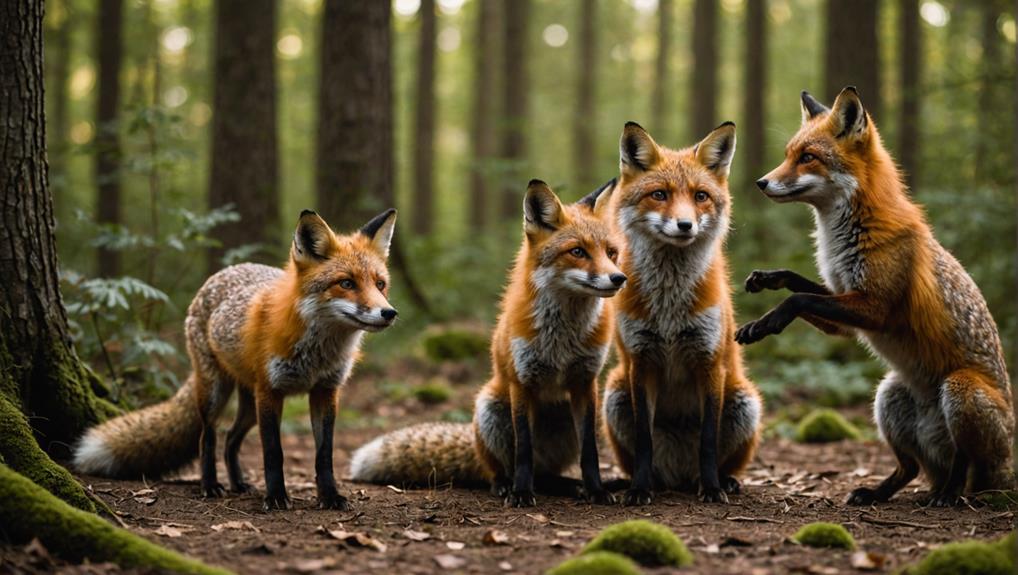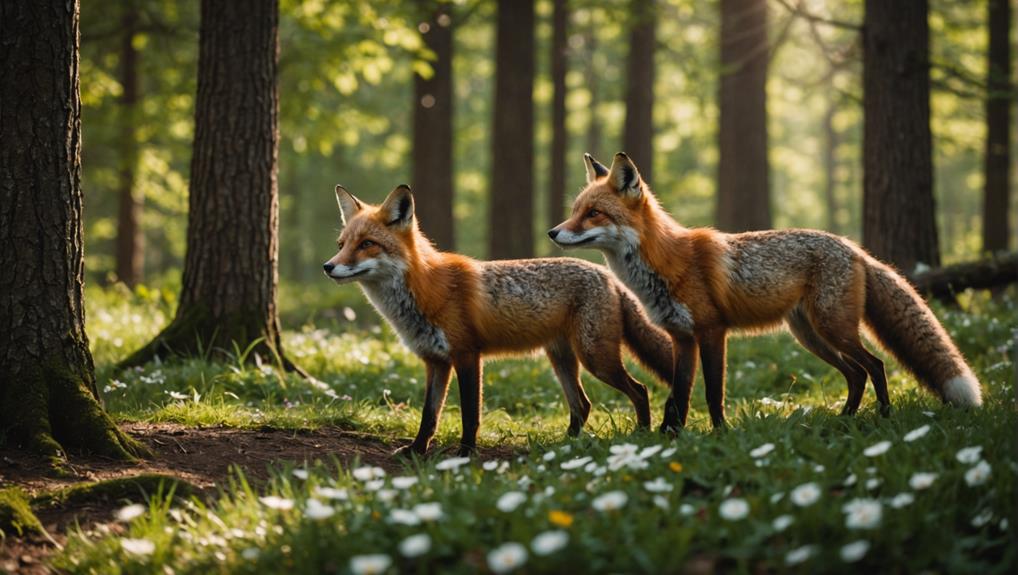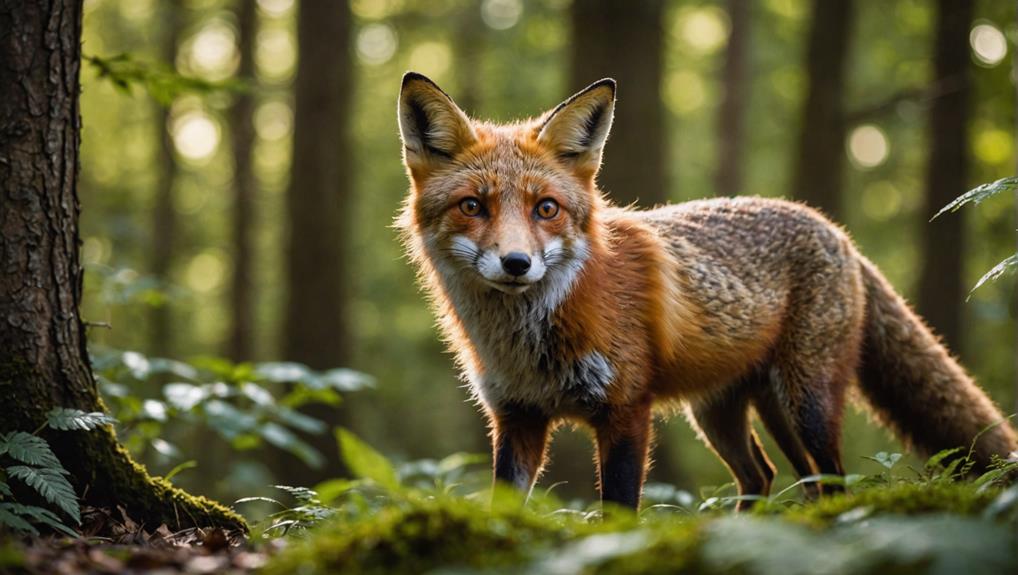Foxes are clever little critters, combining playful energy with a striking independence and adaptability that lets them thrive in different habitats. They're fiercely loyal to their family, often displaying protective instincts towards their pups. With keen senses—like sensitive ears that can hear movements from far away—these creatures are skilled hunters, using stealth and teamwork when necessary. Their playful nature and emotional intelligence make them fascinating to observe, although they can be a bit shy around humans. If you think that's intriguing, there's plenty more about their unique personalities and survival techniques waiting for you to uncover!
Contents
General Characteristics of Foxes
Foxes are fascinating creatures known for their independence and adaptability. You might be surprised to learn that these clever animals can thrive in various habitats, from forests to urban areas.
Their resourceful nature shines through in how they find food, as foxes are often opportunistic eaters, snacking on small mammals, birds, and even fruits when the mood strikes. With approximately 22 recognized species of foxes globally, each has unique traits and adaptations that allow them to survive in their respective environments, including the diverse habitats they occupy.
When you think of a fox personality, you might picture a sly, cunning creature, but there's so much more! Wild foxes exhibit loyal and protective traits, often forming tight-knit family groups.
They communicate with each other using a range of vocalizations, which can sound a bit like a chorus of quirky sounds. Raising their pups is a team effort, with both parents involved, showcasing their nurturing side.
With a gestation period of just 51 to 53 days, you can imagine how excited they must be to welcome a litter of 4 to 5 adorable pups.
Sensory Adaptations
Incredible sensory adaptations allow foxes to thrive in diverse environments and hunt effectively. You might be amazed to learn that their ears are highly sensitive. They can detect small movements from up to 100 meters away! This ability helps them locate prey, making them skilled hunters.
In addition, their keen sense of smell plays an essential role in tracking down food, allowing them to forage efficiently in various habitats, including forests and deserts, showcasing their unique adaptations for survival.
When it comes to vision, foxes shine in low-light conditions, thanks to their unique vertical pupils. This feature enhances their night vision, similar to our feline friends, allowing them to explore the night with confidence.
But wait, there's more! Foxes have long, sensitive whiskers on their face and legs, helping them navigate tricky terrain and find food in tight spaces. Imagine them, whiskers twitching, as they sense their surroundings.
Oh, and let's not forget their impressive dental structure. With 42 sharp teeth designed for gripping and consuming prey, they're well-equipped for their dietary needs.
Social Behavior and Communication

With their impressive sensory adaptations, foxes navigate their environments skillfully, but their social behavior and communication are equally fascinating. These clever creatures rely on vocalizations like yips, barks, and screeches to connect with one another, helping maintain harmony within their small social groups. Formed by a few adults and their cubs, these groups display loyalty and protective traits that are heartwarming to observe.
| Social Behavior | Vocalizations | Protective Traits |
|---|---|---|
| Playful interactions | Yips and barks | Loyal family members |
| Nuzzling during courtship | Screeches to alert | Caring for their cubs |
| Establishing hierarchy | Low body posture | Keeping watch together |
You'll notice that foxes are typically shy and prefer to keep their distance from humans, showcasing their cautious nature. This doesn't mean they're unfriendly; they just like to observe first! Their social interactions, filled with playful antics, reflect a deep investment in family life. So, if you ever spot a fox, take a moment to appreciate the intricate world of communication swirling around them; it's a reminder of nature's beauty and complexity.
Hunting Strategies
When you think about foxes, you might picture them sneaking through the woods, eyes wide and ears perked.
These clever critters are opportunistic hunters, using stealth and camouflage to catch everything from small mammals to unsuspecting insects.
Arctic foxes, for instance, have mastered hunting techniques in the tundra that allow them to detect prey beneath the snow with their keen hearing.
They even team up sometimes, showing that there's strength in numbers when it comes to filling their bellies!
Opportunistic Feeding Behavior
Foxes exhibit remarkable opportunistic feeding behaviors that allow them to thrive in diverse environments.
You'll notice that these clever creatures don't stick to just one type of food; they eat a wide variety, including small prey like mice, birds, and even insects. Imagine a little fox darting through the grass, using its keen senses to hear the slightest rustle from over 100 meters away. That's not just impressive—it's essential for their survival!
Their hunting strategies blend speed and stealth, making them quite the agile hunters.
But here's a fun fact: foxes are also savvy scavengers. They don't shy away from human refuse, which helps them flourish in urban areas.
Plus, they've got a nifty trick up their sleeves—caching! When they find extra food, they'll bury it for later, just like a furry little squirrel.
Stealth and Camouflage Tactics
Stealth defines the hunting success of foxes, allowing them to become masters of their environment. When you watch a fox in action, it's like observing a skilled performer. With their keen sense of hearing and vertical pupils, they can spot even the smallest movements from up to 100 meters away. That's some serious stealth!
But it's not just about their senses. Foxes have a fantastic coat that comes in varied colors and patterns, acting like nature's best camouflage. They blend into their surroundings, enabling them to sneak up on small mammals and birds without being detected.
Their hunting strategies are quite impressive too; they often stalk and pounce, using quick bursts of speed to catch their unsuspecting prey off guard.
And let's not forget those bushy tails! They help with balance during those swift maneuvers, ensuring a smooth hunt.
Foxes are adaptable, switching between hunting and scavenging as needed, showcasing their resourcefulness. So, next time you think of a fox, remember its stealth and camouflage tactics—it's a clever little creature that knows how to thrive in the wild!
Cooperative Hunting Techniques
Cooperative hunting techniques showcase the remarkable social skills of foxes. These clever creatures often band together, especially in family groups, to tackle bigger prey or to outsmart smaller mammals.
Imagine a team of foxes, working in sync, each playing a role in the hunt—one distracts while another moves in for the catch. It's a bit like a well-rehearsed dance, where every twist and turn is carefully coordinated!
Different fox species have developed these strategies to adapt to various environments and food sources. Their opportunistic nature means they can switch tactics, whether it's ambushing or chasing prey, based on what's needed in the moment.
Plus, they communicate through vocalizations and body language, making their teamwork even more effective.
Interestingly, their cooperative hunting skills shine especially bright during seasonal changes. This adaptability helps them navigate the ebbs and flows of food availability, much like wild dogs.
Reproductive Traits

Mating season for foxes unfolds in January and February, when receptive females are in heat for about 20 days, prompting males to actively search for potential mates. During this time, the atmosphere is buzzing with excitement, as the hopeful males showcase their charm and agility.
After a successful courtship, the vixen's pregnancy kicks in, lasting around 51 to 53 days. She typically gives birth to litters of 4 to 5 adorable fox cubs, although sometimes, luck shines, and larger litters of up to 8 can appear.
Parental involvement is essential during this period. The vixen relies on the male to provide food for her and the tiny, blind, and deaf cubs, weighing only about 120 grams at birth.
As these little furballs grow, they start to wean from 4 to 7 weeks old, continuing to suckle until they're about 14 weeks. It's a team effort, with adult foxes bringing back larger prey while the cubs begin their culinary journey with insects and earthworms.
Learning to hunt effectively is an important rite of passage for them, making every moment of parental care critical in shaping their future. So, let's celebrate this remarkable family bond!
Personality and Intelligence
After the nurturing phase of raising cubs, foxes exhibit fascinating personality traits and remarkable intelligence that set them apart in the animal kingdom.
Their cleverness shines through in their problem-solving abilities, making them adaptable in various environments. You might be surprised to learn that these curious creatures also showcase emotional intelligence, which helps them navigate complex social dynamics.
Here are some key traits that highlight their unique personalities:
- Cleverness: Foxes often outsmart other animals and can find creative solutions to challenges.
- Emotional intelligence: They communicate with a variety of vocalizations, reflecting their social nature and understanding of others.
- Playfulness: Their thrill-seeking antics can be downright entertaining, showing their fun-loving side.
- Independence: Foxes thrive on their own, making decisions that suit their adventurous spirits.
- Keen observational skills: Their instincts help them navigate challenges effectively, proving they're quick thinkers.
Frequently Asked Questions
What Are the Behavioral Characteristics of a Fox?
When you observe foxes, you'll notice their clever foraging habits, strong social structures, and varied vocal communications. These traits highlight their intelligence, adaptability, and playful nature, making them fascinating creatures to study and appreciate.
What Are the Key Characteristics of a Fox?
When you explore fox characteristics, you'll notice their diverse habitat preferences, intricate social structures, and unique communication methods. Understanding these aspects will help you appreciate their adaptability and how they interact within their environments.
What Is the Personality of a Fox as a Pet?
If you're considering a fox as a pet, remember they're spirited and curious. Ideal fox owners embrace training challenges, employing fox training tips to nurture bonds while steering through the unique quirks that come with these enchanting companions.
What Is the Stereotypical Personality of a Fox?
When you think of a fox, you picture clever socialization and playful mischief. Their wild behavior showcases adaptability and independence, but don't underestimate their sociable nature; they thrive in engaging, complex social dynamics with others.
Final Thoughts
Foxes are fascinating creatures, balancing their cleverness with a playful spirit. They're not just cunning hunters; they're also social beings who communicate in unique ways. Imagine a sly fox darting through the trees, its sharp senses on high alert, yet it can also curl up with its family, sharing warmth and companionship. This blend of independence and social connection makes them truly special. So next time you spot one, remember the delightful complexity behind their swift, bushy-tailed antics!














